
10 Myths About Managing SaaS for Software Asset Management Pros – Debunked
Table of Contents ToggleMyth #1: SaaS Is in the Cloud, So...
Back
Back
Search for Keywords...
Blog

Table of Contents
Think you’re all set with your Software Asset Management tool? Well, think again. There’s one enterprise software management tool missing from your SAM program: a SaaS Management platform (SMP).
This is not to suggest that you should ditch your SAM tool. An effective software management program requires both a SAM tool and SaaS Management platform.
“You need to have both [an SMP and a SAM tool] because you have two fundamentally different types of software in the enterprise.”
– Jason Owens, Sr. Director of Global ITAM at Salesforce
Gartner agrees. In fact, “Gartner’s market definition distinguishes SMPs from adjacent market tools, because SMPs offer a complete set of capabilities, whereas adjacent market tools provide only some of the capabilities (of a SaaS Management Platform).” (2022 Market Guide for SaaS Management Platforms)
More and more businesses are recognizing the need for specialized tools to manage different types of software effectively. Today, 60% of Zylo customers supplement their SAM tool with a SaaS Management platform.
If on-prem and SaaS are both software, why do you need two separate tools?
Before going into the reasons why you need two separate enterprise software management tools, let’s discuss why SaaS Management is so important.
It is all because of decentralized purchasing. Lines of business and employees have become the primary buyers of software. Together, they’re responsible for 84% of applications and 74% of software spending. With an average of 660 applications in the enterprise, that means SAM only sees a fraction of the full picture.
Several challenges trickle down as a result:
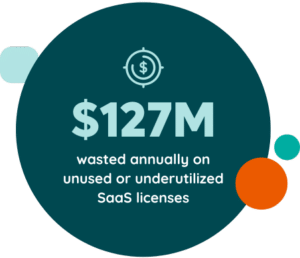 Uncontrolled expense spend and shadow IT. 3.4% of employees expense SaaS in the enterprise, comprising less 1% of spend. That doesn’t sound like much, but with $284M in average spend, that’s still millions of dollars you don’t know about.
Uncontrolled expense spend and shadow IT. 3.4% of employees expense SaaS in the enterprise, comprising less 1% of spend. That doesn’t sound like much, but with $284M in average spend, that’s still millions of dollars you don’t know about.Managing software assets effectively requires specialized enterprise software management tools for both on-premises and SaaS. Using a Software Asset Management tool alongside a SaaS Management platform ensures you’re managing your software holistically. To understand their differences, compare a SaaS Management Platform vs a SAM tool here.
Here are five reasons to integrate both tools into your software asset management strategy.
As mentioned before, enterprises average 660 applications and spend $284M annually on SaaS. The sheer size of the modern tech stack highlights the need for more scalable solutions.
Using a SAM tool for SaaS inventory management often involves a manual process. Each application must be individually added along with its corresponding usage, contract, and spending data. This method becomes particularly cumbersome and inefficient when managing a large scale of software applications.
In contrast, a SaaS Management platform is built to handle such extensive inventories efficiently by automating the process. And that leads nicely into the second reason: discover all your SaaS.
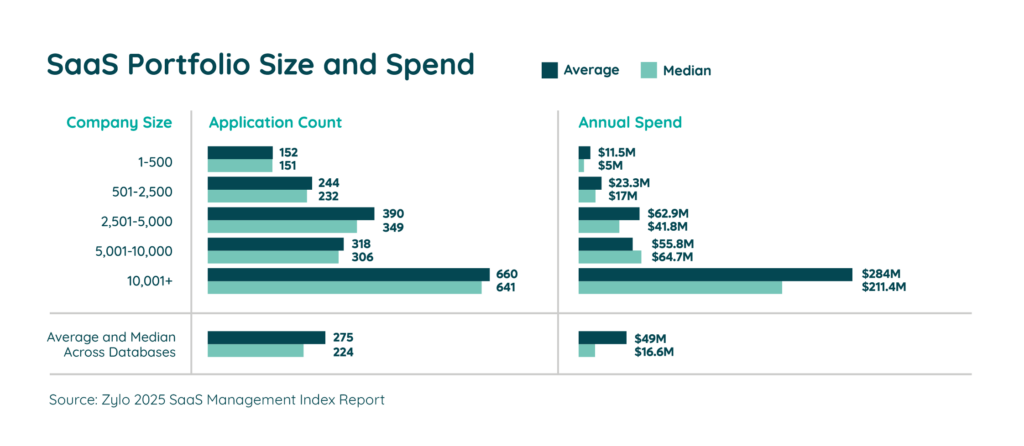
Discovery is a critical foundation to a successful SAM program, because you can’t manage what you can’t see. With business units and employees responsible for 74% of spending and 84% of applications, SAM has limited visibility at best. In addition, purchases made by employees via expense are difficult to track down. That’s because 51% of software is miscategorized in expense reports.
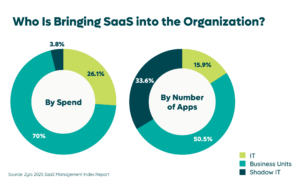 SAM tools only track the applications you enter manually. They often fail to capture software managed outside the conventional procurement process, especially SaaS expensed by employees.
SAM tools only track the applications you enter manually. They often fail to capture software managed outside the conventional procurement process, especially SaaS expensed by employees.
In contrast, SaaS discovery is where SMPs excel. At Zylo, we use an AI and machine learning model focused on financial discovery. Initial discovery typically reveals that organizations spend 3X more and have 1.7X more applications than they expect.
When it comes to expense discovery, Zylo’s Discovery Engine discovered $600K in SaaS spending for a customer, starkly contrasting the $36K identified through traditional vendor matches.
The greatest value of an SMP is that discovery isn’t one and done. It’s ongoing to ensure new applications are detected over time.
From a comprehensive discovery perspective, here are a few real-world examples that highlight results:
In a SaaS world, enterprises need more comprehensive and ongoing discovery to support the rationalization of software assets, reducing risks, and avoiding unexpected renewals.
How the Zylo Discovery Engine Powers the Most Comprehensive SaaS Management Platform
Learn MoreBecause SaaS purchasing is decentralized, it’s more important than ever to partner with other stakeholders across the business. Typically, Software Asset Management teams collaborate with IT, Procurement, and lines of business. Collaboration and communication across departments create a more secure, compliant, and cost-effective software management system.
A SAM tool tends to be a blocker to collaboration, because only the SAM team can access it. Yet, it’s the opposite with a SaaS Management platform. Any relevant stakeholder can easily access and use an SMP, giving you one place to holistically manage your SaaS.
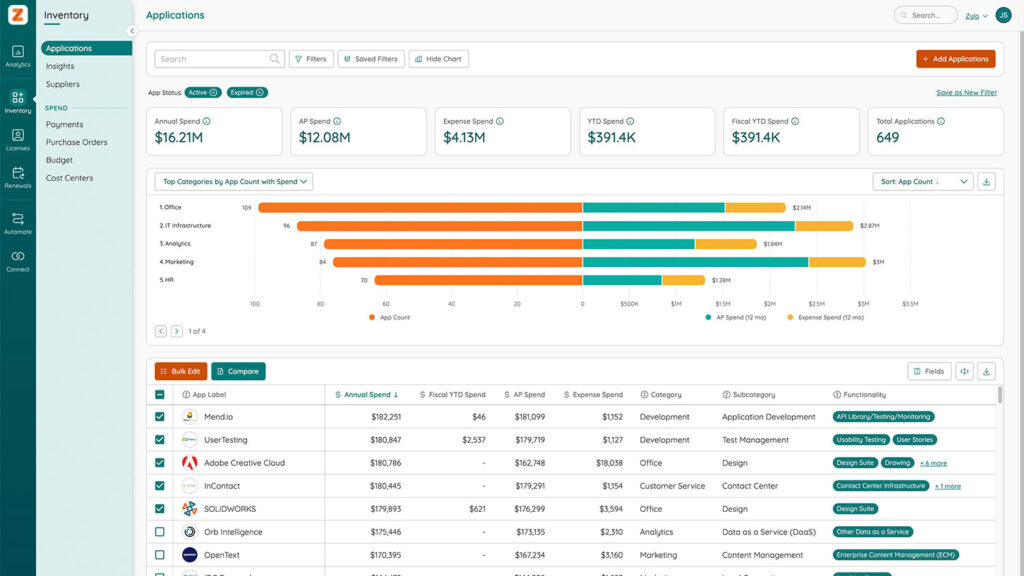
Here’s a breakdown of use cases and how SAM collaborates with IT, Procurement, and the business.
Drive SaaS Renewal Decisions
SAM is a valuable advisor and partner to Procurement and lines of business leaders for decision making around renewals. When a SaaS renewal comes up, SAM provides data and insights to kick off the conversation. How well is the application being used? Do we want to renew it? Do we need to add or reduce licenses?
A collaborative approach ensures you make the best decision for the business and have a plan in place once the renewal date rolls around. Ultimately, it means aligning your procurement strategies with actual usage and business needs.
Reduce Operational Burden
SAM’s regular involvement in license management reduces IT’s operational burden, allowing for a more agile response to changing needs within the software environment. Collaboration between SAM and IT ensures that your software stack is compliant and optimally configured to meet evolving business demands.
Optimizing Costs
As we’ve discussed, enterprises spend a lot on SaaS – and waste a lot, too. SAM is a key partner to IT for optimizing software expenditures. By establishing regular audits and access controls, you can mitigate risks and ensure compliance. For instance, you may revoke licenses for users with unnecessary admin-level access, thus enhancing data security and reducing financial waste.
Enterprises face an average of 476 renewals annually, translating to about two renewals per business day. That makes it very hard to plan for or cancel auto-renewals without proactive planning.
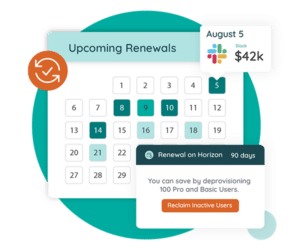 A SaaS Management platform includes renewal management, helping SAM proactively manage renewals and make data-driven decisions. For instance, Zylo is the only platform that consolidates inventory, spend, usage, license, and contract data in one place. This centralized data powers helpful tools like a renewal calendar, automated alerts to upcoming renewals, data insights, and benchmarking.
A SaaS Management platform includes renewal management, helping SAM proactively manage renewals and make data-driven decisions. For instance, Zylo is the only platform that consolidates inventory, spend, usage, license, and contract data in one place. This centralized data powers helpful tools like a renewal calendar, automated alerts to upcoming renewals, data insights, and benchmarking.
This is a significant upgrade over many SAM tools, which may lack renewal management features or include them only in a limited, manual form.
Using an SMP simplifies the renewal process and ensures that comprehensive, real-time data informs every decision. As a result, businesses can stay ahead of their contractual obligations and reduce software costs.
Software Asset Management projects are notorious for taking a long time. To start, implementing a SAM tool often involves a significant investment of resources, with setup times ranging from 6 to 12 months. And then your projects are often limited to only a few major ones per year.
In contrast, a SaaS Management Platform offers pre-built integrations and automation features that significantly speed up the time to value. It enables enterprises to see cost savings and compliance improvements in weeks rather than months or quarters.
The IT and SAM teams at FIS experienced this first hand.
“Zylo enabled us to provide value we’ve never been able to before. All of a sudden we are armed with data to allow the business to make a better decision,” shared Jason Carney, SVP, CRO, CSO, and Business & IT Asset Management. “Within 6 months of a 2 year project, we are already at over 80% of our savings target.”
Even long term, it pays off. Several years into using Zylo, Adobe has unlocked $60M in cost savings and avoidance.
The discovery and visibility we discussed in reasons one and two are what make this possible. By addressing easily resolvable issues early – often called “low-hanging fruit” – you can achieve quick wins that contribute to broader strategic benefits.
Adobe Drives Innovation and Massive Savings with Zylo
In the past 4 years, Adobe has rapidly scaled from $9B to $18B. This growth has made an already complex environment even more complex. Learn how they leveraged Zylo to get complete visibility into their SaaS portfolio, unlock millions in cost savings and avoidance and improve the employee experience.
What if you don’t use a SaaS Management platform? The flipside is you keep trying to make a SAM tool work – like fitting a square peg in a round hole. Your business is likely to incur consequences such as operational risks, inefficiencies, overspending, and noncompliance.
Don’t let your software assets become a liability. It’s time to use an enterprise software management tool purpose built for SaaS. Embrace complete visibility and control with Zylo, the comprehensive solution for software asset managers.
“We’ve had [a SAM tool] for on-prem for a long time, and we gave them a shot at SaaS. SaaS Management [for us] is Zylo.”
– Technology Asset Management leader from a 30k-employee pharmaceutical company
Learn how Zylo can transform your software management approach and help you stay ahead in a rapidly evolving digital landscape. Meet with us today and start your journey towards effective SaaS Management with Zylo.

Table of Contents ToggleMyth #1: SaaS Is in the Cloud, So...
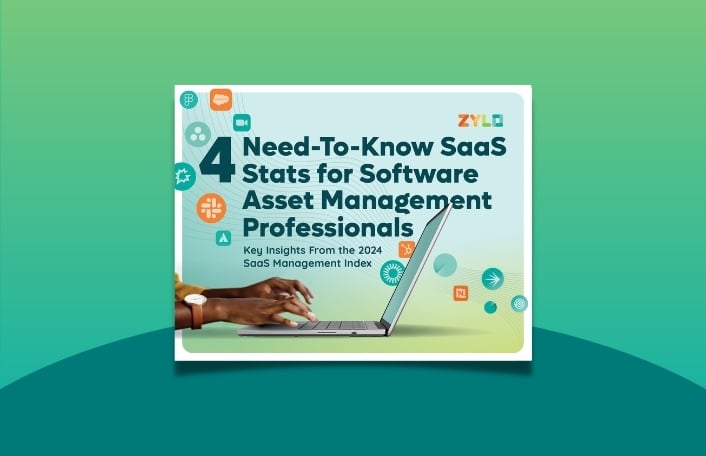
Don’t Let the Status Quo Hold You Back SaaS is fundamentally...

Table of Contents ToggleWhat Are Longtail SaaS Applications?The Rise of Longtail...

Table of Contents ToggleNASA Software Audit Lesson #1: Visibility Must Be...
| Cookie | Duration | Description |
|---|---|---|
| cookielawinfo-checkbox-analytics | 11 months | This cookie is set by GDPR Cookie Consent plugin. The cookie is used to store the user consent for the cookies in the category "Analytics". |
| cookielawinfo-checkbox-functional | 11 months | The cookie is set by GDPR cookie consent to record the user consent for the cookies in the category "Functional". |
| cookielawinfo-checkbox-necessary | 11 months | This cookie is set by GDPR Cookie Consent plugin. The cookies is used to store the user consent for the cookies in the category "Necessary". |
| cookielawinfo-checkbox-others | 11 months | This cookie is set by GDPR Cookie Consent plugin. The cookie is used to store the user consent for the cookies in the category "Other. |
| cookielawinfo-checkbox-performance | 11 months | This cookie is set by GDPR Cookie Consent plugin. The cookie is used to store the user consent for the cookies in the category "Performance". |
| viewed_cookie_policy | 11 months | The cookie is set by the GDPR Cookie Consent plugin and is used to store whether or not user has consented to the use of cookies. It does not store any personal data. |
